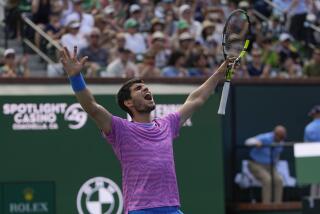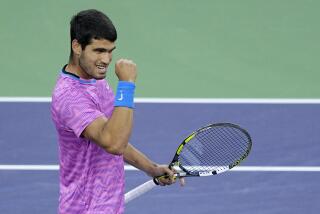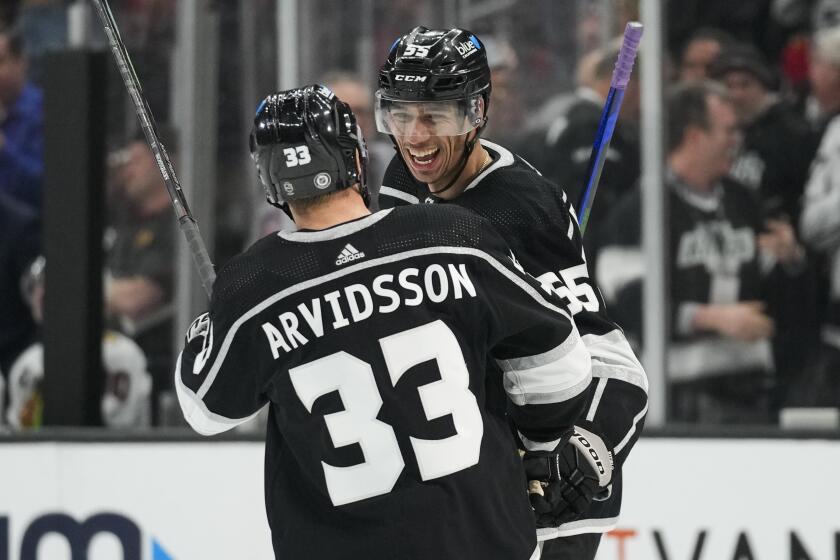Despite Roger Federer’s finesse, the tennis world was sent a strong message at Indian Wells
On a day in the desert when a 21-year-old from Croatia took Roger Federer to the brink, two 20-year-old women did their final preparations for the biggest tennis moment of their lives.
Is it time to roll out the clichés? Is the torch passing? Is youth being served in the world of pro tennis?
In the evening chill of a half-empty stadium Friday in the prestigious BNP Paribas Open, Daria Kasatkina and Naomi Osaka beat the odds and the expectations of most tennis fans by winning their way into Sunday’s women’s final. Kasatkina beat a legend, 37-year-old Venus Williams, in a match of drama and shot-making. Osaka beat the current No. 1 player on the WTA Tour, 26-year-old Simona Halep, by hitting harder and smarter and dispatching the sulking Romanian in two quick sets. Kasatkina’s victory was a dogfight, 4-6, 6-4, 7-5. Osaka was a walk in the park, 6-3, 6-0.
Kasatkina comes from Russia not only with love, but with a steady game and a world of promise. Osaka, of a Haitian father and a Japanese mother, plays for Japan by way of Fort Lauderdale, Fla. She moved to the United States when she was 3, holds dual citizenship, speaks no Japanese, but is a delight in English.
“It’s cool [to be in the final],” she said, “because there are fewer players around and there is a lot of sushi left.”
Williams was 17 when Kasatkina was born. She has won $40 million in her career, Kasatkina $2.8 million. Williams has been playing on the women’s tour since 1997, the year Kasatkina was born. Williams has won seven major titles. Kasatkina has played in 28 Grand Slam singles matches.
Osaka will be the baby in Sunday’s final. She is five months younger than Kasatkina, but also 25 spots lower in the rankings at No. 44. She has won $1.5 million on the tour and has found herself and her game at Indian Wells, taking out none other than Maria Sharapova in the first round, followed by victories over the former No. 2-ranked Agnieszka Radwanska and Karolina Pliskova, a two-time semifinalist here.
Even more than their ages, the respective styles of Kasatkina and Osaka should make Sunday’s final fascinating. Kasatkina attacks less, is solid from both forehand and backhand sides and is somewhat of a counter-puncher along the lines of Caroline Wozniacki. Osaka is more flamboyant, hits bigger shots and can win spectacularly, or lose the same way.
Kasatkina said, “Even when I’m not playing really good, like I don’t feel forehand or backhand, I’m still trying to reach every ball and fight for every point. I think this is coming from childhood.”
Which wasn’t all that long ago.
While both are so young, each is aware of a changing of the guard in tennis, and their current statement to that end.
Osaka said, “I feel like there is a new generation, and we’re trying to push through.”
Kasatkina was even more to the point.
“[I think] that we are coming,” she said. “Very soon.”
Federer’s survival in the men’s semifinal Saturday against Borna Coric felt a bit like a desperate statement for the old, familiar names and faces in the game. And only a genius shot-maker and strategy-thinker the caliber of Federer would have made it through that match.
But Father Time is assessing the scene in pro tennis. Kasatkina is right on.
The kids are coming.
sports@latimes.com
More to Read
Get our high school sports newsletter
Prep Rally is devoted to the SoCal high school sports experience, bringing you scores, stories and a behind-the-scenes look at what makes prep sports so popular.
You may occasionally receive promotional content from the Los Angeles Times.







